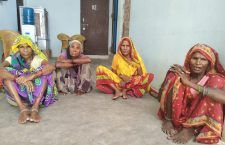A village in the Prime Minister’s constituency reeling from an infestation of mosquitoes and the death knell that brings.
“The government can’t save us from mere mosquitoes. Forget about attacks from Pakistan and India!”
60-something Vijay Narayan Singh, resident of Dhaurhara village in the district of Benares in Uttar Pradesh, is only being partly melodramatic for the sake of the camera, we know. As the Khabar Lahariya editor Meera Jataw told us in the newsroom later, “Those mosquitoes really seem to have declared war!”
It’s a foggy morning in Dhaurhara, but it’s not an early chill, or the infamous northern smog. It is mosquito repellent. Being sprayed quite generously through the lanes and bylanes of the gaon, almost as an illustration of what the village pradhan Geeta Yadav shares with us confidently, “Chhidkaav toh lagatar chal raha hai (The fogging is happening continuously).” Her statement is accurate, but unfortunately only so for the last three weeks; the fact of the matter is that the dengue and malaria outbreak in Dhaurhara has been an ongoing one for the last six months.
Several people in Dhaurhara have death-by-dengue tales to share, while still others speak of being afflicted by it, or caring for a family member afflicted by it. Om Prakas Yadav’s mother passed away on August 22. Someone else mentions a son, a daughter, a husband, a wife. Pappu, local activist, remembers the monsoons as the beginning of the saga, when the drain overflowed, while Girish Yadav, another local activist, cites May this year as the beginning of the “dengue prakop”. According to Yadav, there have been at least nine deaths due to dengue in Dhaurhara since June and July and he accuses the local health officials of extreme apathy, “Whenever they do health camps here, they check for blood pressure and sugar. When people with high fevers went to the camps, people who were visibly weak, and asked for check-ups, they were told it’s just a viral fever that would pass in a week’s time. If you go check the records at the centre even today, you’ll find no deaths recorded, due to dengue. Sab lipa-poti ho chuki hai wahaan. It cites reasons such as heart attack and diabetes.”
Yamuna Singh Yadav tells us in detail what it entails to be sick in Dhaurhara, “You get a raging fever, you can’t move. But somehow you get yourself to the government hospital, where you’re told the doctor is absent today, come tomorrow. The next day, you’re told parchi katwa lo, line mein lag jaao, but then you find that the guy who sanctions the receipts, is absent today. Again you’re told to come tomorrow. Now, in that state, the person just wants to get better. He will probably seek out private medical care at that point. Here, in Dhaurhara, for many people, that would mean taking a loan, because you cannot afford the consultation plus medication. And of course, all the while you’re unwell, you can barely make it to the site where you work, for your daily wages.” He goes for rhetoric, “So, isn’t it the government’s responsibility to ensure we get the healthcare we’re promised?” Everyone around him mumbles Ayushman Bharat as a pithy phrase echo.
Girish Yadav rants about the adverse effects of the disease on every aspect of village life – the market, the school – how sales drop and children miss studies. “People have even migrated from here in the last four months because of this,” he adds. Detected with dengue himself, Girish offers his own tale as a case in point, “It’s a treacherous disease and imagine the additional suffering you have to go through. I first showed up at the Dhaurhara primary healthcare center, where I was informed that this kind of treatment is not available here, that there is no proper medication. They referred me to go visit Benares, where I had to wait for two whole days, before I even got to a doctor. When I told them I needed treatment for dengue, that I had already been diagnosed, they told me to go and treat myself on my own then.”
In 2016, the residents of Dhaurhara were notified that the government had issued regulations to deal with dengue fever. Under this, the Additional Chief Medical Officers of all the districts of Uttar Pradesh were considered as the Controlling Authority. In district hospitals, it was mandatory for dengue patients to be provided with 10 beds and at the Community Health Centers, this number was billed at five. In 2017, when the state government changed, Dhaurhara was not informed of any changes in this planning.
Speaking to the local healthcare workers – every villager’s first line of defence in the case of diseases – we’re not surprised at the state Dhaurhara finds itself in today. Kusum Yadav, the ASHA worker, tells us that she hands out the mandatory Paracetamol to whoever turns up at her doorstep or the centre with a fever. She offers nothing much else – she’s been given no training or literature around monsoon-borne diseases. Renu Yadav, the local Anganwadi worker, speaks only of the constant relapses occurring in Dhaurhara, which have her deeply mystified. “Somehow the fever just keeps coming back.”
Meanwhile, amidst the fogging, dengue camps – the need of the hour – are still awaited. The residents of Dhaurhara find no solace in the fact that winter is indeed coming.
This Khabar Lahariya article first appeared on Firstpost.

